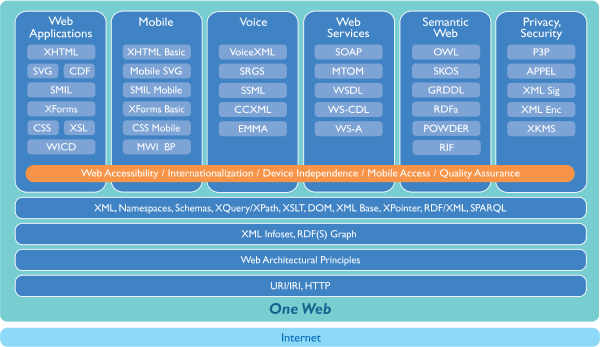 Media Kit
Media KitThe World Wide Web Consortium (W3C) was created in October 1994 with a mission to lead the Web to its full potential. W3C primarily pursues its mission through the standardization of Web technology, although W3C also engages in education and outreach, develops software, and serves as an open forum for discussion about the Web. In order for the Web to reach its full potential, the most fundamental Web technologies must be compatible with one another and allow any hardware and software used to access the Web to work together. W3C refers to this goal as "Web interoperability." By publishing open (non-proprietary) standards for Web languages and protocols, W3C seeks to avoid market fragmentation and thus Web fragmentation.
W3C is a vendor-neutral, non-profit organization. Organizations from all over the world join W3C to participate in the creation of Web standards. W3C Members and a dedicated full-time staff of technical experts have earned W3C international recognition for its contributions to the Web. W3C Members (sample testimonials), staff, and invited experts work together to design technologies to ensure that the Web will continue to thrive in the face of an growing diversity of people, hardware, and software.
Tim Berners-Lee and others created W3C as an industry consortium dedicated to building consensus around Web technologies. Mr. Berners-Lee, who invented the World Wide Web in 1989 while working at the European Organization for Nuclear Research (CERN), has served as the W3C Director since 1994. A more detailed history of the Web and a longer biography of Tim Berners-Lee are available.
In its first ten years, W3C has published more than 80 Recommendations. A W3C Recommendation is considered a Web standard. The "Recommendation" label indicates that a W3C specification is stable, contributes to Web interoperability, and has been reviewed by the W3C Membership, who favor its adoption by the industry. A timeline of W3C Recommendations is available.



ERCIM,
Keio University and MIT
W3C is an international industry consortium whose operations are supported by Membership dues and grants from a variety of sources. W3C is jointly run by the MIT Computer Science and Artificial Intelligence Laboratory (CSAIL) in the USA, the European Research Consortium for Informatics and Mathematics (ERCIM) headquartered in France and Keio University in Japan. W3C also has World Offices in fourteen regions around the world. W3C Offices work with their regional Web communities to promote W3C technologies in local languages, broaden W3C's geographical base, and encourage international participation in W3C Activities.
The W3C Communications Team is your first point of contact for information on Web standards and the technologies under development at the W3C. We are available to answer your questions and connect you with W3C's technical experts.
We encourage you to send all press requests to w3t-pr@w3.org. This will allow the Communications Team to attend to your request in a timely manner. If you have questions prior to sending your requests, please contact the following W3C representatives:
Below you will find some of W3C's most important achievements. Obviously, this type of list is subjective and does not represent every aspect of W3C work. For a complete view, please consult the list of W3C Activities and the index of W3C's technical reports.
The Web is an application built on top of the Internet.
W3C is transforming the architecture of the initial Web (essentially HTML, URIs, and HTTP) into the architecture of tomorrow's Web. Each W3C technology not only builds on the previous, but is designed so that it may be integrated with future specifications as well. To meet the growing expectations of users and the increasing power of machines, W3C is already laying the foundations for the next generation of the Web. W3C's technologies will help make the Web a robust, scalable, and adaptive infrastructure for a world of information.

Current work is expanding the reach of the Web to anyone (regardless of culture, abilities, etc.), anything (on devices ranging from powerful computers with high-definition displays to smaller palm devices, and from general purposes consumer products to specialized tools), anywhere (from high to low bandwidth environments), and via any mode of interaction (touch, pen, mouse, voice, assistive technologies, computer to computer). These new technologies will lead to new discoveries, expand commercial opportunities, increase benefits, and create and solve new challenges for humankind. The following sections describe some of the realities around the corner.
With the ubiquity of Web browsers and Web document formats across a range of platforms and devices, many developers are using the Web as a platform-independent application environment. Examples of Web applications include reservation systems, online shopping or auction sites, games, multimedia applications, calendars, maps, chat applications, clocks, interactive design applications, stock tickers, currency converters and data entry/display systems. For more information on developing platform-independent applications, please refer to the work of the W3C Compounds Document Formats Activity.
We are witnessing a growing interest in the integration of Semantic Web and Web services technologies; indeed that the two models — the former data-centric and the latter message-centric — are both important to networked and distributed systems. Web services are seen as the way for organizations to do business with each other as well as with people.
The multimodal Web will transform how we interact with applications. W3C is developing standards that support multiple modes of interaction, through eyes, ears, and touch. Today, most people are familiar with the input mechanisms of keyboard, mouse, and stylus, as well as the output mechanisms of graphics and audio. Already today, additional access mechanisms have begun to appear, in particular, dialog interactions through spoken prompts, voice input, and audio feedback. The goal of the W3C Multimodal Interaction Activity is to enable more people to carry out more activities via the Web and to take advantage of the strengths of each means of access.
The mobile Web will make Web access from a mobile device as simple, easy and convenient as Web access from a desktop device. Even though many of today's mobile phones include Web browsers, accessing the Web from a mobile device has not become as popular as expected. Users and content providers are facing difficulties such as Web site usability and single authoring for all mobile phones offering Web access.
W3C's Web Accessibility Initiative (WAI) continues to promote implementation of existing accessibility guidelines in advanced authoring tools, together with improved evaluation tools. This progress will enable more automated support for development and repair of accessible Web sites. In this way, accessible Web design will become "business as usual." This progress will also allow people with disabilities to more easily contribute content to the Web. Increased implementation of accessibility guidelines for browsers and media players, combined with personalized accessibility profiles, and use of metadata and proxy services to support accessibility, will enable people with disabilities to more readily access and interact with the Web.
W3C's vision of the Web is one of a truly integrated environment that allows for the expression of cultural nuances. W3C's Internationalization Activity has started work on guidelines that explain to developers how to ensure that their XML formats support internationalization and efficient localization. Other internationalization work will focus on common locale identifiers and negotiation for the World Wide Web and Web services in particular. These technologies will allow rich support for culture and language differences across distributed systems and geographies.
As a rule-based policy management system, a new generation of policy-aware Web technology can hold the key for providing open, distributed and scaleable information access on the World Wide Web. The publication of declarative access policies in a way that allows significant transparency for sharing among partners without requiring pre-agreement is envisioned. In addition, greater control over information release can be placed in the hands of the information owner, allowing, for example, discretionary (rather than mandatory) access control to flourish. There is a need for developing protocols and user interface strategies to enable the full range of transparency, compliance management, and accountability required for the policy aware Web. W3C's goal is to use the power of the Web, and enhance it where necessary with new technology, to give users and site operators tools to enable better knowledge of privacy practices and control over personal information.
The Platform for Privacy Preferences Project (P3P) enables Web sites to express their privacy practices in a standard format that can be retrieved automatically and interpreted easily by user agents. But P3P is not enough to enforce the policy advertised on the Web. A long standing idea was to make the privacy metadata (policy under which the data was collected) travel with the collected personal data. This way, all data-users down the disclosure chain would be able to determine what they can do and what they can't do with the data in question. But P3P is not a formal language for writing enterprise privacy policies to govern data-handling practices in IT systems according to fine-grained positive and negative authorization rights. It concentrates on the core privacy authorization while abstracting data models and user-authentication from all deployment details such as data model or user-authentication. An enterprise privacy policy language like EPAL could remedy the situation. For more information, please refer to the Privacy Activity page.
Copyright © 2004 W3C® (MIT, ERCIM, Keio), All Rights Reserved. W3C liability, trademark, document use and software licensing rules apply. Your interactions with this site are in accordance with our public and Member privacy statements. Photo credits: Olivier Théreaux; Cédric Kiss; Gehry Partners, LLP